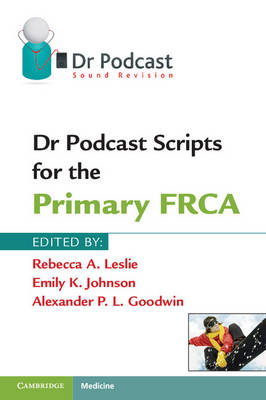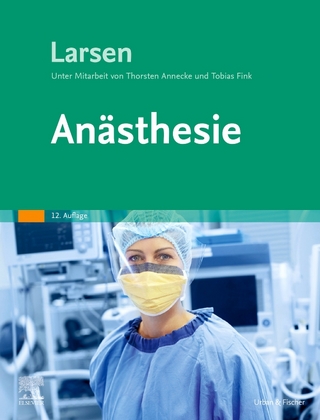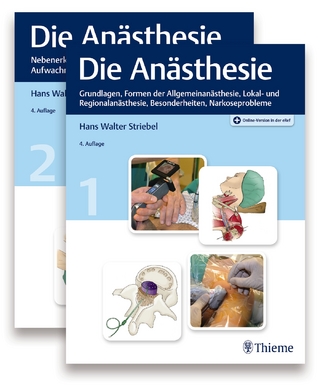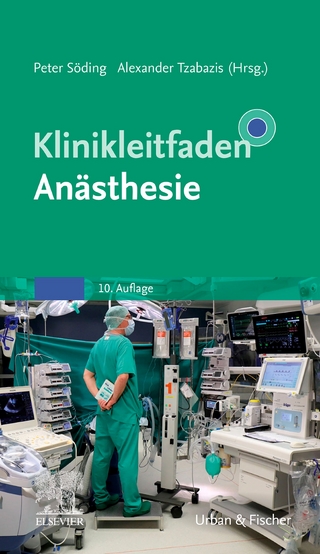
Dr Podcast Scripts for the Primary FRCA
Cambridge University Press (Verlag)
978-1-107-40101-3 (ISBN)
Dr Podcast (www.dr-podcast.com) is a great way to revise for the FRCA exams and has been met with widespread enthusiasm from candidates. It provides podcasts of questions and model answers with no redundant material. Dr Podcast scripts are now available in print format. Containing the scripts of all 90 individual podcasts from the Dr Podcast Primary FRCA collection, they also include diagrams the reader can draw to explain their answers. They cover the entire syllabus for the Primary FRCA, allowing the readers to experience the style of the questions likely to be asked and providing tips on how to excel in the exam. Each podcast is written by a successful candidate who has insight and experience of the exam, and all material has been reviewed by experienced consultants with detailed knowledge of the educational standards. For those preparing for the Primary FRCA exams, Dr Podcast scripts are a must.
Rebecca A. Leslie is a Specialist Registrar in Anaesthesia, Severn Deanery, Bristol, UK. Emily K. Johnson is a Specialist Registrar in Anaesthesia, West Midlands Deanery, Birmingham, UK. Alexander P. L. Goodwin is Consultant in Anaesthesia and Intensive Care, Royal United Hospital, Bath, UK.
Preface; Part I. Physiology: Section 1. Respiratory Physiology: 1. Lung volumes; 2. Respiratory compliance; 3. Ventilation, perfusion and dead space; 4. Alveolar gas equation and shunt; 5. Hypoxic pulmonary vasoconstriction; 6. Oxy-haemoglobin dissociation curve; 7. Altitude physiology; Section 2. Cardiovascular Physiology: 8. Cardiac cycle; 9. Coronary circulation; 10. Pacemaker cells; 11. Valsalva manoeuvre; 12. Exercise physiology; Section 3. Physiology of the Central, Peripheral and Autonomic Nervous System: 13. Cerebral circulation; 14. CSF; 15. Blood brain barrier; 16. Action potentials; 17. Reflex arc; 18. Spinal cord; 19. Autonomic nervous system and adrenergic receptors; Section 4. Physiology of the Neuromuscular Junction: 20. Neuromuscular junction; 21. Muscle physiology; Section 5. Fluids and Renal Physiology: 22. Fluid balance; 23. Acid-base physiology; 24. Renal physiology; Section 6. Liver and Endocrine Physiology: 25. Glucose and metabolism; 26. Pituitary and endocrine function; 27. Thyroid gland; 28. Adrenals; 29. Starvation and stress response; 30. Liver and clotting; 31. Proteins and haemoglobin; Section 7. Immunology: 32. Immunology; Part II. Pharmacology: Section 8. Pharmacological Principles: 33. Pharmacokinetics; 34. Drug action and receptors; 35. Drug interactions; 36. Agonists and antagonists; 37. Isomers; Section 9. Intravenous Induction Agents: 38. Propofol and thiopentone; 39. Etomidate and ketamine; Section 10. Inhalational Anaesthetic Agents: 40. Inhalational agents; 41. MAC; 42. Nitrous oxide; Section 11. Neuromuscular Blocking Agents and Anticholinesterases: 43. Neuromuscular blocking agents; 44. Suxamethonium; 45. Anticholinesterases; Section 12. Local Anaesthetics: 46. Local anaesthetics; Section 13. Analgesic Agents: 47. Analgesic agents; Section 14. Drugs Acting on the Central Nervous System: 48. Anti-convulsant agents; 49. Benzodiazepines; Section 15. Drugs Acting on the Cardiovascular System: 50. Anti-hypertensive agents; 51. Anti-arrhythmic agents; 52. Inotropes; Section 16. Drugs Acting on the Gastrointestinal and Endocrine Systems: 53. Drugs acting on the GI tract; 54. Anti-emetic agents; 55. Hypoglycaemic agents; Section 17. Antibiotics: 56. Antibiotics; Section 18. Anticoagulants: 57. Anticoagulants; Section 19. Statistics: 58. Statistical analysis; 59. Statistical data; Part III. Physics: Section 20. Units of Measurement: 60. SI units; Section 21. Biological Signals and their Measurement: 61. Biological signals; 62. Electrocardiogram; 63. Neuromuscular monitoring; Section 22. Gas Flow and its Measurement: 64. Gas laws; 65. Flow; 66. Measurement of gas volume and flow; Section 23. Gas Supply and Delivery: 67. Cylinders and gas supply; 68. Breathing systems; 69. Vaporisers; 70. Soda lime and carbon dioxide absorption; 71. Scavenging; Section 24. Measurement of Oxygen, Carbon Dioxide and Anaesthetic Agents: 72. Measurement of anaesthetic agents; 73. Oxygen measurement; 74. Pulse oximetry; 75. pH and carbon dioxide measurement; 76. Capnography; Section 25. Temperature and Humidification: 77. Heat loss; 78. Temperature and its measurement; 79. Humidification; Section 26. Pressure Measurement: 80. Pressure measurement; 81. Blood pressure measurement; 82. Resonance and damping; 83. Intracranial pressure measurement; 84. Cardiac output measurement; Section 27. Electricity: 85. Electricity; 86. Electrical safety; Section 28. Equipment: 87. Defibrillators; 88. Lasers and diathermy; 89. Ultrasound; Index.
| Erscheint lt. Verlag | 5.5.2011 |
|---|---|
| Zusatzinfo | 7 Tables, black and white; 119 Line drawings, unspecified |
| Verlagsort | Cambridge |
| Sprache | englisch |
| Maße | 155 x 235 mm |
| Gewicht | 680 g |
| Themenwelt | Medizin / Pharmazie ► Medizinische Fachgebiete ► Anästhesie |
| Medizin / Pharmazie ► Medizinische Fachgebiete ► Schmerztherapie | |
| Medizin / Pharmazie ► Studium | |
| ISBN-10 | 1-107-40101-1 / 1107401011 |
| ISBN-13 | 978-1-107-40101-3 / 9781107401013 |
| Zustand | Neuware |
| Haben Sie eine Frage zum Produkt? |
aus dem Bereich



